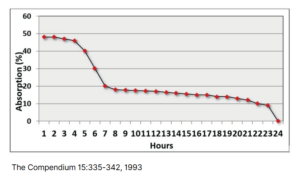Znaczenie siary dla koźląt mlecznych
Prawidłowe zarządzanie siarą ma kluczowe znaczenie dla zdrowia i przetrwania koźląt mlecznych. Siara dostarcza niezbędnych składników odżywczych i ochrony immunologicznej, które są niezbędne dla noworodków, które rodzą się bez naturalnej odporności wymaganej do obrony przed patogenami środowiskowymi. Biorąc pod uwagę, że 50% zgonów koźląt występuje w ciągu pierwszych 24 godzin z powodu braku siary, karmienie wysokiej jakości siarą wkrótce po urodzeniu ma kluczowe znaczenie dla zapewnienia ich przetrwania. W tym artykule zbadamy znaczenie siary, jej skład odżywczy i istotną rolę, jaką odgrywa w zapobieganiu wczesnym chorobom u koźląt. Ponadto omawiamy protokoły zarządzania siarą, w tym wykorzystanie alternatywnych źródeł siary, środki ostrożności dotyczące zanieczyszczenia siary, aby zapewnić, że jest ona bezpieczna do spożycia.
Skład odżywczy siary
- Siara jest bogata w składniki odżywcze, które wspierają zdrowie noworodków:
- Energia (tłuszcze): Pomaga regulować temperaturę ciała i zapobiega hipotermii. Białka (immunoglobuliny): Przeciwciała IgG są niezbędne do ochrony immunologicznej przed patogenami.
- Witaminy: Witaminy rozpuszczalne w tłuszczach, takie jak A, D i E, wspomagają funkcje odpornościowe, wzrost i rozwój kości.
- Minerały: Niezbędne pierwiastki, takie jak wapń, selen i magnez, wspierają rozwój szkieletu i funkcje metaboliczne.
Protokół zarządzania siarą: Czas, ilość i jakość
Skuteczne zarządzanie siarą obejmuje uwzględnienie czasu, ilości, jakości i czystości siary:
1. Czas: Wchłanianie przeciwciał jest najbardziej efektywne w ciągu pierwszych godzin życia, kiedy jelito dziecka może wchłonąć duże białka, takie jak immunoglobuliny. Niektóre publikacje sugerują, że okres "otwartego jelita" trwa do 24 godzin, podczas gdy inne badania wskazują, że może on trwać do 36 godzin. Jednak ogólnie przyjmuje się, że siara powinna być podawana tak szybko, jak to możliwe, najlepiej w ciągu 2 godzin po urodzeniu, aby zmaksymalizować odporność.
2. Ilość: Nowonarodzone koźlęta powinny otrzymać 15-20% masy ciała w siarze w ciągu pierwszych 24 godzin. Można to podzielić na kilka karmień, zaczynając od 5-7% BW w pierwszym karmieniu, a następnie mniejszymi karmieniami, aby osiągnąć cel. Na przykład dziecko o wadze 3 kg powinno otrzymać około 150-210 ml w pierwszym karmieniu.
3. Jakość: Siara wysokiej jakości zawiera ponad 50 gramów IgG na litr, mierzonych za pomocą refraktometru Brix powyżej 25%. Siara średniej jakości mieści się w przedziale 22-25% Brix (około 20-50 gramów IgG/L), podczas gdy siara niskiej jakości ma mniej niż 20 gramów IgG/L (poniżej 19% Brix). Upewnienie się, że siara ma wystarczającą ilość IgG jest niezbędne do zapewnienia odpowiedniej ochrony immunologicznej dziecku.

Metody sztucznego karmienia: Butelka lub rurka
Siara powinna być podawana w temperaturze ciała, około 38,5-39,5°C, która jest normalną temperaturą ciała noworodka. Karmienie butelką jest preferowaną metodą, ponieważ pozwala dziecku ssać naturalnie, ale karmienie przez sondę może być stosowane, jeśli dziecko jest zbyt słabe, aby ssać. Karmienie przez rurkę zapewnia, że dziecko otrzymuje niezbędną objętość, ale wymaga umiejętności i ostrożności, aby uniknąć zranienia dziecka lub spowodowania zachłystowego zapalenia płuc. Maksymalna pojemność żołądka nowonarodzonego koźlęcia wynosi około 7-10% jego masy ciała, dlatego należy uważać, aby nie przekarmić zwierzęcia.
Wymagania dotyczące IgG dla koźląt
Ilość immunoglobuliny G (IgG), którą powinno otrzymać nowonarodzone koźlę, ma kluczowe znaczenie dla zapewnienia prawidłowego transferu odporności biernej. Zalecane minimalne spożycie IgG wynosi od 8,7 do 13 gramów na kilogram masy ciała. Dla przykładu, koźlę o wadze 3 kg potrzebuje od 26,1 do 39 gramów IgG w ciągu pierwszych 24 godzin, aby zapewnić odpowiednią ochronę immunologiczną. Wytyczne te są poparte badaniami, które pokazują, że dzieci otrzymujące mniej niż tę ilość IgG są bardziej podatne na niepowodzenie w przekazywaniu odporności biernej i mają wyższą zachorowalność i śmiertelność.
Alternatywne źródła siary dla koźląt
W sytuacjach, gdy siara matki jest zanieczyszczona, niedostępna, niewystarczająca lub o niewystarczającej jakości, można zastosować alternatywne źródła siary:
1. Siara od innej kozy: Jeśli jest dostępna, można użyć siary od innej zdrowej kozy. Nadmiar siary od kozy należy zebrać i zamrozić w małych, jednorazowych porcjach (200-250 ml). Zamrożoną siarę należy rozmrozić w ciepłej kąpieli wodnej w temperaturze poniżej 50°C/122°F, aby zachować składniki odżywcze i zawartość immunoglobulin.
2. Preparat zastępujący siarę: Dostępne są komercyjne preparaty zastępujące siarę, które stanowią dobry substytut siary matczynej. Produkty te są często oparte na wołowinie i opracowane tak, aby dostarczać co najmniej 50 g IgG na litr, co jest odpowiednikiem wysokiej jakości siary koziej. Dobry zamiennik powinien podnieść stężenie IgG w surowicy dziecka powyżej 15 gramów na litr, zapewniając wystarczającą ochronę.
Środki ostrożności dotyczące stosowania siary
Należy zachować ostrożność przy wyborze źródła siary, ponieważ skażona siara może stanowić poważne zagrożenie dla zdrowia noworodków. Należy unikać podawania siary pochodzącej od matek dotkniętych chorobą:
- Artretyczne zapalenie mózgu kóz (CAE)
- Mykoplazma
- Przypadkowe zapalenie węzłów chłonnych (CL)
Patogeny te mogą być przenoszone na młode poprzez siarę, powodując długotrwałe problemy zdrowotne, a nawet śmierć. W stadach, w których choroby te stanowią zagrożenie, pasteryzacja siary lub stosowanie komercyjnych preparatów zastępujących siarę może być najbezpieczniejszą opcją.
Wnioski i podsumowanie
Podsumowując, skuteczne zarządzanie siarą jest niezbędne dla zdrowia i przeżycia koźląt mlecznych. Kluczowe punkty obejmują:
- Karmienie wysokiej jakości siarą w ciągu pierwszych 2 godzin życia, aby zapewnić wchłanianie niezbędnych przeciwciał.
- Dostarczenie łącznie 15-20% masy ciała dziecka w siarze w ciągu pierwszych 24 godzin, z co najmniej 8,7-13 gramami IgG na kilogram masy ciała.
- Korzystanie z alternatywnych źródeł siary, gdy jest to konieczne, przy jednoczesnym zapewnieniu właściwej obsługi i unikaniu przenoszenia chorób przez skażoną siarę.
Przestrzegając tych wytycznych, hodowcy kóz mogą znacznie zmniejszyć śmiertelność i poprawić ogólny stan zdrowia i witalność swoich stad.
Referencje
Chigerwe, M., Tyler, J. W., et al. (2008). Colostral Immunoglobulin G Concentrations in Dairy Goat Colostrum. Journal of Dairy Science, 91(5), 1853-1861.
Weaver, D. M., Tyler, J. W., et al. (2000). Passive Transfer of Colostral Immunoglobulins in Newborn Dairy Calves. Journal of Dairy Science, 83(5), 924-930.
Przewodnik użytkowania refraktometru Brix. (2021). Podręcznik zarządzania kozami mlecznymi.
USDA. (2020). Pasteryzacja siary dla małych przeżuwaczy. Narodowy Instytut Żywności i Rolnictwa.
